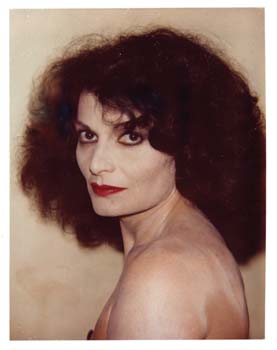Diane von Furstenberg
- 1984
- Andy Warhol (American 1928-1987, né Andrew Warhola)
- Polacolor ER
9.5 x 7.3 cm., 3-3/4 x 2-7/8" image
- Gift of the Andy Warhol Foundation, Augustana College Art Collection, 2008.12.12

Essay by Emily Cox, Class of 2011
Pop icon Andy Warhol worked in various media throughout his career, but by the early 1960s, photography became a major impetus for his creative energy. In 1970, Warhol purchased a Polaroid Big Shot camera. What other technology was better suited to the tastes of Warhol than the Polaroid camera? Warhol reveled in mass-produced art and was fascinated by the instant, as well as instantly disposable, notion of celebrity. As he moved through the New York art and club scenes, Warhol always had his camera in hand in order to document the world of glamour and celebrity, and the ever-changing cast of characters with whom he mingled. The Polaroid camera allowed him to capture, with his characteristic voracity, everyone from the famous, such as Muhammed Ali, Georgia O'Keefe and, as seen here, Diane von Furstenberg (199A), to the completely anonymous everyday pedestrian. Such snapshots also enabled him to circumvent copyright infringement challenges inherent in his commercial images. Most of Warhol's Polaroids were used as studies for eventual silk-screen portraits and were never formally exhibited during his lifetime.
In 1982, Warhol designed the cover for Diana Ross' music album, Silk Electric (199B). The design was based on a previous Polaroid print taken by Warhol of Ross at his Factory studio. The look as a whole should elicit déjà vu for the viewer in relation to the adjacent Warhol Polaroid piece. The hair, make-up, and over the shoulder pose closely resemble Warhol's Polaroid portrait of Diane von Furstenberg (199A). Warhol would often cover his subjects' faces in white kubuki makeup and finish the look with intense red lips and dark eyes. By doing this his celebrities are stripped of their individuality. They become commercialized and easily reproduced along the lines of Warhol's famous 200 Campbell's Soup Cans and other familiar popular consumption goods. By comparing the elements of his Polaroid portrait with this stylized translation into lithography, one can discern the duality of commercial realism and abstraction in the transformation of a person into a commodity. This is possibly a comment from Warhol on the nature and idea of celebrity.
